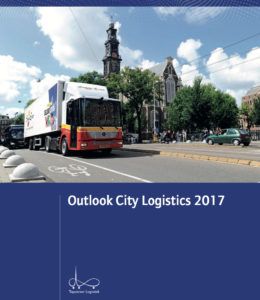Logistics are vital to ensuring that a city is both dynamic and pleasant to live. Organizing city logistics operations more efficiently and more sustainably can significantly reduce the negative aspects of vibrant cities, such as pollution and noise.
In collaboration, TNO, CE Delft and Connekt have developed the Outlook City Logistics 2017, to show how changes in city logistics can help achieve the Paris climate goals by 2050.
Top Sector Logistics
“Top Sector Logistics is fully aware that something needs to be done. In order to achieve the targets in the Paris agreement by 2050, the Netherlands needs to reduce emissions of greenhouse gases in transport and mobility by 80-95% compared to 1990. This comes down to transporting each kilogram of freight six times more efficiently. In other words, much more freight transport while achieving lower emission levels. How are we going to accomplish this? As it is, stakeholders tend to point the finger at one another when it comes to looking for solutions and adopting them. This is why we developed the Outlook City Logistics, in order to gain more insight into realistic possibilities and to share the benefits and burdens more equally between the different parties within the city,” explains Herman Wagter of Connekt, the commissioning party and actively involved in the management of the project.
Collaboration
TNO, CE Delft, and Connekt have developed the Outlook City Logistics with the support of Amsterdam University of Applied Sciences. CE Delft has extensive knowledge of the emissions that are produced by different modes of transport, and which factors affect these emissions.
This expertise has been combined with TNO’s expertise in this area and in the field of logistics innovations market characteristics and developments. Walther Ploos van Amstel, who is researching innovative city logistics at Amsterdam University of Applied Sciences, was added to the team to look at Outlook City Logistics 2017 from a business perspective.
“The aim is to use the Outlook City Logistics to develop a future-proof vision and strategy in several steps by means of backcasting,” Herman Wagter emphasizes. “With four parties joining forces to innovate together, we hope to promote a shared vision and common way of thinking. We have come up with several possible transition scenarios that we hope the sector can recognize and support. Right now it is important to elaborate which assumptions are used, in order to open up the discussion with, and among, the stakeholders. In this first version we have not yet specified who needs to do what.”
Reduce congestion
Switching to electric freight transport is one way to successfully reduce CO2 emissions in the city, but this does not reduce congestion. Cleaner technology is very important, but organizing things differently opens up new opportunities. The use of sensors to track goods and vehicles and applying robotics and automation also offers opportunities to increase flexibility, productivity and efficiency. “One example might be a system where the driver knows when a loading and unloading space is free, so he doesn’t waste time waiting or looking for a different space. And who knows? In some cases, it might be possible to combine passenger transport and logistics,” Walther Ploos van Amstel of AUAS reflects.
TNO Time interviewed the project member about the making of the Outlook Citylogistics. Read this interview by clicking here.

